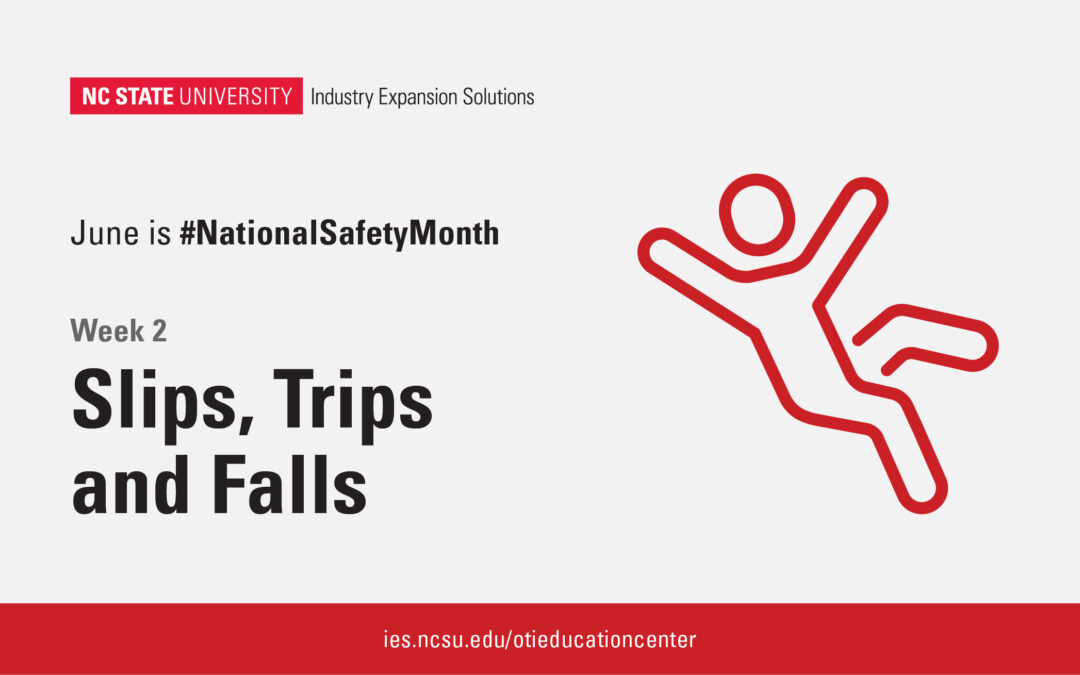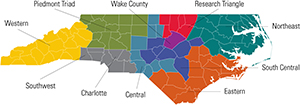June is National Safety Month! Week 2 focuses on Slips, Trips and Falls.
Slip, Trip and Fall events can happen anywhere! Trips, slips, and falls are among the most common incidents that lead to serious injuries. However, with awareness and simple preventive measures, we can significantly reduce the risk of these events. In this blog, we will explore the causes behind trips, slips, and falls and provide practical tips on how to avoid them both at home and in the workplace.
1. Identify and Eliminate Hazards
The first step in preventing slip, trip and fall incidents is to identify potential hazards. Regularly inspect your surroundings and look for tripping or slipping hazards, such as loose rugs, cluttered pathways or wet floors. At work just as with home environments, inspect areas focusing on environments and items which could become slip or trip hazards. Slippery surfaces or a quarter-of-an-inch crack in the pavement could cause an incident. Report any safety concerns to your supervisor or facility management. Promptly addressing these hazards can create a safer environment for everyone.
2. Maintain Cleanliness and Order
Keeping your living space or workspace clean and organized prevents accidents. Make it a habit to pick up items from the floor and put them in their designated places. Avoid leaving electrical cords, toys, trash bins, furniture or other objects in walkways. In the workplace, ensure that equipment, tools and materials are stored properly after use. Maintaining cleanliness and order minimizes the risk. Remember to put away that phone or other items that may cause distractions. .
3. Adequate Lighting
Poor lighting can contribute to trips and slips, particularly in areas with uneven surfaces or obstacles. Install sufficient lighting in every room, including hallways, staircases and entrances. Report any malfunctioning or inadequate lighting to the appropriate authorities in the workplace. Well-lit areas provide better visibility and reduce the chances of accidents.
4. Secure Rugs and Mats
Rugs and mats can easily become hazards if improperly secured. Use double-sided adhesive tape or non-slip backing to keep them in place. Consider removing unnecessary rugs or mats altogether to eliminate potential hazards. Ensure that rugs and mats in the workplace are flat and securely anchored to the floor to prevent accidents. Replace wet rugs and mats due to weather or spills when identified.
5. Wear Appropriate Footwear
The type of footwear you choose can also play a significant role in preventing slips and falls. Opt for footwear based on the nature of the conditions. There are a variety of options including but not limited to, slip-resistant, puncture-resistant, rubber, and electro-static dissipative varieties for your feet, ankle and knee protection. Choose footwear suitable for the conditions and activities you will be engaged in.
6. Use Handrails and Grab Bars
Handrails and grab bars are invaluable safety features that provide stability and support, particularly on staircases or bathrooms. Make sure handrails are securely fastened and that grab bars are correctly installed. Encourage their use at home and promote their maintenance and sanitation at work to help prevent falls and assist those needing additional support.
Trips, slips and falls are avoidable incidents that can cause significant injuries and disrupt our daily lives. By taking proactive measures at home and in the workplace, we can minimize the risk of these events. Regularly inspecting and addressing hazards, maintaining cleanliness, ensuring adequate lighting, securing rugs and mats, wearing appropriate footwear and utilizing handrails and grab bars are essential to creating safer environments. Prevention is key and a little effort goes a long way in safeguarding ourselves and those around us from these common accidents. Stay safe and stay upright!
Join us June 14 from 9 a.m. – 10 a.m. for the OSHA Training Requirements Webinar
Many of OSHA’s workplace safety standards include training requirements. While some standards provide clear details specifying the frequency, duration and content of the training, other standards are less descriptive. In this session, we will review the common training topics from 29 CFR 1910 and provide a resource to help determine the training your workers need and how to meet OSHA’s training requirements.
This webinar is for all types of businesses, safety managers, safety directors, and anyone with safety responsibilities.



